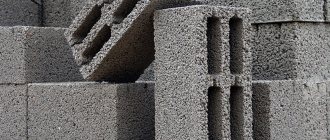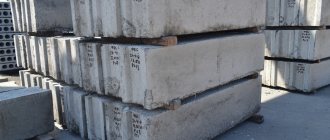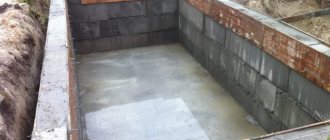Cinder blocks can be solid, the structure of which contains a large number of solid particles, or hollow.
Such a stone has voids, due to which its weight is lighter and thermal conductivity increases. When constructing a building using hollow cinder blocks, you need to know its features.
What does the concept mean?
A hollow building material made from a mixture of slag and Portland cement has from 28 to 40% voids in its composition . During production, these voids are made as follows: after pouring the concrete solution into the molds, cone formers are lowered into them, which make holes that do not reach the end of the bottom of the block. When the product dries, it will have several holes.
Hollow cinder blocks are also called slotted, since in addition to round holes, slotted voids can be made in them.
The building material itself is successful in the construction of internal walls and partitions of residential buildings. Due to the reduction in the amount of solid particles in the composition, such raw materials have insignificant weight compared to solid blocks.
What are they and what are their differences?
There are several types of slotted cinder blocks:
- with two holes;
- with three holes;
- four-slit;
- 7-slit;
- with square two holes.
Cinder block with two holes:
With three holes:
4-slit cinder block:
7-slot:
With two square holes:
The listed cinder blocks differ in appearance and hole configuration. In some stones they are made in the form of a cone, with most of them facing up. In other stones, the holes look like long rectangular strips. Where the holes are round, there are more voids, and where the holes are rectangular, the voids occupy less volume of the stone.
Reference! In addition to light weight and good thermal insulation, cinder blocks have a good ability to insulate a room in noise and sound.
Requirements according to GOST
According to construction standards, there are requirements for hollow cinder blocks. They are regulated in the document GOST 6133-99. It is said here that slotted stone for construction is a wall block with through or non-through (with a bottom) vertical voids, which are obtained during the molding process. These voids give the products the necessary performance properties .
When selling a cinder block, its marking must contain the letters “PS”, which means hollow. For example, the designation of a stone will contain the following signs:
- K-stone;
- S, P, L, R – wall, partition, front silt;
- PS – hollow;
- length in centimeters;
- strength grade;
- frost resistance grade.
According to GOST requirements, the dimensions of the stone from the slag mixture must comply with the document. Deviation of length and width dimensions by +-3 mm, height by +-4 mm is allowed . External defects in excess of the permissible size standards are not allowed on the stone. Sinks on cinder block should not be deeper than 4 mm. Grease stains with a diameter of more than 10 mm on the surface of such a block are not allowed.
Making a mold for cinder block
Without a special brick-making press, it is advisable to make cinder blocks if you have started a small-scale construction of a garage, summer kitchen, or bathhouse. To build a large house, you will need a large number of cinder blocks and the process of their production will take a lot of time and effort.
You can assemble the mold for pouring cinder blocks with your own hands. It is a parallelepiped with side dimensions of 40x20x20 cm. The given dimensions are again standard and you can change them at your discretion.
molds for cinder blocks with metal walls
The mold for pouring cinder blocks is often made from solid wooden boards; metal sheets can also be used. The boards should have a smooth surface for easier removal of the block. It consists of four side boards, that is, of two identical-sized pairs of boards, all four boards should be the same in height and a fifth board for the bottom of the mold. They also make molds without a bottom, but the floor of the room or street where the molds will be poured must be prepared, level, hard and clean. To speed up the process, they knock down and make a mold for several cinder blocks, 5-10 pieces at once, with partitions inside.
wooden molds
What kind of walls are they used for?
Hollow cinder block stone is used only for laying interior walls of a house or partitions .
This is due to its low strength and inability to withstand heavy loads. For the construction of external, main walls, which are the support for the floors, only solid stones are used.
For example, if the load-bearing walls of a house are built from hollow cinder blocks with 3 holes, they will not be able to support the load. Due to the fact that the hollowness of such stones is 28-40%, they do not have the proper strength .
Over time, when choosing this block for the construction of permanent walls, cracks may form on the surface of the masonry, and the wall itself will sag and be in disrepair.
Note! This material is just suitable for interior walls. There is no need to serve as the main support here, so a hollow block will fit in place. It is also good to build partitions from raw materials: special partition blocks of convenient sizes are even produced for this purpose.
Why do you need to consider block parameters?
Before purchasing cinder block as a building material for building walls, you need to carefully study its characteristics.
This will help ensure that the material is suitable for a specific purpose. For example, the void ratio affects the purpose of cinder concrete - either it is used for a load-bearing wall or for a partition wall.
Before purchasing, it is important to ask the seller of the product for information about product certification. For example, if a product does not have environmental and safety certificates that indicate the manufacturer, the composition of slag concrete, and its characteristics, then you should not purchase this product. Not only is it unsafe, but it will not be strong and durable.
The appearance of the product must also be ideal, of the same shape and color. The dimensions of the walls should not be different, and the walls themselves should not have a large number of cracks, chips, depressions, or broken corners.
Purchased products should only be stored on pallets , and not by conventional storage, and the storage location should be under a canopy so that the cinder blocks do not become damp or saturated with moisture.
Hollow products should only be folded with the voids facing down.
Main characteristics
A hollow cinder block has several characteristics:
- frost resistance – from F15 to F50;
- weight – from 10.5 to 14 kg;
- walls of partitions between voids - at least 20 mm;
- compressive strength - from 35 to 150 kg/sq.cm;
- density according to GOST - 1650 kg/m3;
- strength grade - M-125, M-100, M-75, M-50, M-35;
- thermal conductivity - from 0.35 to 0.48 W/m °C.
We should also talk about the size of the hollow stone. The most common are 200x200x400 mm (20x20x40 cm), as well as 390x190x188 mm, 390x120x188 mm, 390x90x188 mm . The last two sizes are used for laying partitions, as they have a reduced width, due to which they do not “steal” space in the house.
How to correctly lay stone with voids?
Compared to laying solid blocks, the construction of walls made of hollow stone has several features:
First, pull the cord to make markings.- The laying is done after finding the highest point of the foundation.
- The solution is applied to the foundation, then a block is applied and its position is leveled with a mallet.
- The solution is immediately applied to the end parts of the block.
- If stones with slotted holes on the sides are used, then the solution must be applied to the ends of the strips.
- The stone is pressed tightly to the masonry with your hands.
- Each row must be checked by a tight cord or level.
Additionally, it is recommended to use a special arrangement: a device that allows you to create a gap between the stones for a mortar joint of a certain thickness. After installing the block, the order is removed and used when laying the next stone.
Read more about how to properly lay all types of cinder blocks here.
Compound
Slag concrete blocks contain aged slag of certain fractions. The grain size of slag sand is a parameter that determines the properties of slag concrete products. The binding components are mainly cement and lime. For the solution, clean water or specially acidified water is used. Known material formulations require, in addition to slag, the use of cement, brick and concrete chips, crushed stone screenings, ash, volcanic perlite, sand, expanded clay, etc.
Reduced thermal conductivity of products is given by pine needles and sawdust. Reducing the size of stone-like fillers gives the blocks high strength and additional weight. However, low thermal conductivity and mass are achieved by using larger fractions. Thus, the characteristics of granulated slag are decisive.
Slag-alkaline concrete has a special composition. The mixture includes ground sand slag, selected alkaline solution, large and small aggregates. Lightweight slag-alkaline concrete is created on the basis of blast furnace granulated slag or expanded clay. At the same time, the mixture contains room for agloporite, pumice, limestone (shell rock), and wood waste.
Return to contents
Pros and cons of use
The use of hollow cinder blocks has several advantages:
- light weight;
- low thermal conductivity;
- efficiency;
- presence of holes.
Due to the light weight, the load on the foundation will be minimal, and no equipment will be needed to lift the blocks onto the masonry. Voids retain heat in the room more easily; such a house will always have a comfortable temperature . In a separate article you can learn how to insulate a house with cinder blocks.
Due to the fact that the stone contains about 28-40% voids, the cost of its production is less, therefore, the final cost will be cheaper than that of a solid stone. The presence of holes will help to lay communications inside.
Among the disadvantages of this building material: it does not withstand too much physical stress , and also, due to the presence of holes, it does not allow you to properly hang anything on the wall.
Average prices
Hollow stone is sold on the same basis as solid blocks, so finding it will not be difficult.
On average, 1 stone measuring 390x190x188 mm with 4 slots will cost 41 rubles , and a cubic meter of such material will cost 2950 rubles.
For a partition block measuring 390x120x188 mm you need to pay 36 rubles, and for a cube of material - 4500 rubles.
If you buy a 7-slot cinder block for walls with dimensions of 390x190x188 mm, then for a joke they will ask on average 47 rubles, and for a cube - 3300 rubles.











